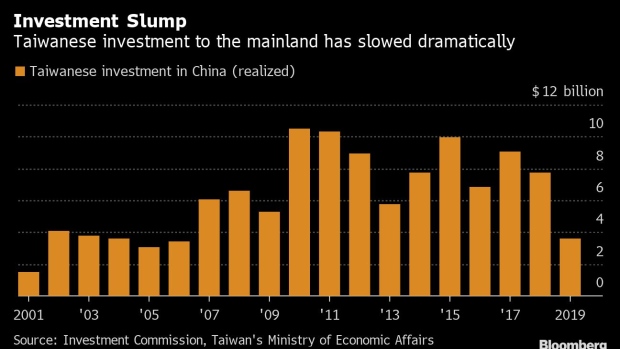May 5, 2020
Virus Adds to Asia’s Push to Lure Investment Away From China
, Bloomberg News

(Bloomberg) -- Economic ties between the U.S. and China have been under increasing strain the last few years. The trade war, more scrutiny and controls on investment, national-security concerns and now the pandemic have all been factors in calls for a decoupling between the two largest economies.
Those issues are also having an effect on investment and trade between China and its Asian neighbors, with a number looking to take advantage of the trade war to attract investment, or to deliberately steer their supply chains away from China.
The U.S. was only the sixth-largest source of direct investment for China in the first 10 months of 2019; what Taiwanese, Japanese, or South Korean companies and governments do is just as consequential for how global investment and supply chains are configured.
Taiwan
Taiwan’s government has been looking to bring back at least some of its companies back from the mainland, and the success of such programs is one of the reasons its economy outperformed South Korea and other peers last year. In 2019, Taiwanese firms realized NT$217 billion ($7.3 billion) from China under one incentive program to invest at home.
As of the end of April, Taiwanese firms -- which have invested in China for more than two years and have been hit byu the trade war -- have promised to invest NT$752 billion, according to a government report this month, with that program and the trade war likely contributing to the slump in investment flowing to the mainland last year.
Japan
Japan is another nation which is now looking to encourage its companies to move from China, setting aside $2.3 billion of its pandemic stimulus package to help firms move supply chains back to Japan or elsewhere.
“Considering the concerns about the effect on Japan’s supply chains of a decrease in the supply of goods from China and elsewhere, for high-value added goods which are reliant on output in just one nation, we plan to bring production back to Japan,” Prime Minister Shinzo Abe said on March 5. “For other goods, we shouldn’t rely on just one nation, but diversify production to the countries of Asean and elsewhere.”
Although the budget has only just been passed and firms will likely wait to see how the record economic downturn affects the domestic economy, at least one company has already moved to increase domestic production.
Iris Ohyama Inc., a privately-held company making household goods, announced in late March that it would start domestic production of face masks. While the company already has two factories in China making masks, it said that rising demand and the increased risks of overseas production meant it would start production in Japan from next month.
India and Vietnam
As well as investor nations trying to bring firms back or at least diversify from China, other countries are trying to attract some of that money.
Vietnam was already a favored location for foreign investors looking for an alternative manufacturing hub to China following escalating trade tensions with the U.S. Now, India is looking to businesses moving out of China with an offer of land almost double the size of Luxembourg, Bloomberg reported this week.
However, China is still an attractive destination for many foreign companies, especially those that sell to Chinese consumers. The mainland is now the largest car market in the world, and even though sales have fallen for more than a year, it’s highly unlikely companies like Toyota Motor Corp. or Hyundai Motor Co. would move production out of the country.
Other international firms are increasing their investment in the country, with Samsung Electronics Co. investing $8 billion in a second plant to make memory chips in Xi’an, China, after a $7 billion investment in 2017, according to the city government late last year. And Tesla Inc. is already selling cars from its new multi-billion-dollar factory in Shanghai.
Even some U.S. firms are still keen to beef up their presence. In a survey in December 2019, before the virus outbreak, about 20% of U.S. companies in China said that investing there was there first priority, and almost 40% ranked it as a top-three priority, according to a Chamber of Commerce survey.
©2020 Bloomberg L.P.





